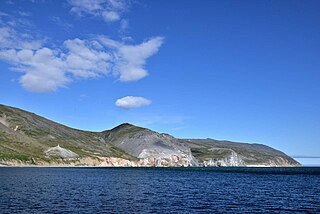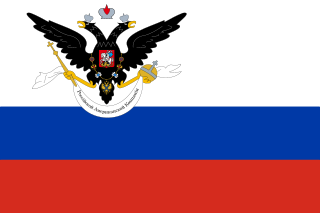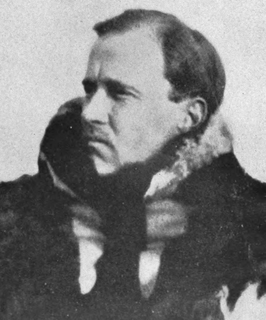Related Research Articles

The Bering Strait is a strait between the Pacific and Arctic oceans, separating the Chukchi Peninsula of the Russian Far East from the Seward Peninsula of Alaska. The present Russia-United States maritime boundary is at 168° 58' 37" W longitude, slightly south of the Arctic Circle at about 65° 40' N latitude. The Strait is named after Vitus Bering, a Danish explorer in the service of the Russian Empire.

The Chukchi, or Chukchee, are an indigenous people inhabiting the Chukchi Peninsula, the shores of the Chukchi Sea and the Bering Sea region of the Arctic Ocean within the Russian Federation. They speak the Chukchi language. The Chukchi originated from the people living around the Okhotsk Sea. According to recent genomic research, the Chukchi are the closest Asiatic relatives of the indigenous peoples of the Americas as well as of the Ainu people.
Joseph Billings was an English navigator, hydrographer and explorer who spent the most significant part of his life in Russian service.

Cape Dezhnyov or Cape Dezhnev, formerly known as East Cape or Cape Vostochny, is a cape that forms the easternmost mainland point of Asia. It is located on the Chukchi Peninsula in the very sparsely populated Chukotka Autonomous Okrug of Russia. This cape is located between the Chukchi Sea and the Bering Strait, 82 kilometres (51 mi) across from Cape Prince of Wales in Alaska; the Bering Strait is delimited by the two capes. The Diomede Islands and Fairway Rock are located in the midst of the strait.

Chukotka Autonomous Okrug, or Chukotka (Чуко́тка) is the easternmost federal subject of Russia. It is an autonomous okrug situated in the Russian Far East, and shares a border with the Sakha Republic to the west, Magadan Oblast to the south-west, and Kamchatka Krai to the south. Anadyr is the largest town and the capital, and the easternmost settlement to have town status in Russia.

The fur trade is a worldwide industry dealing in the acquisition and sale of animal fur. Since the establishment of a world fur market in the early modern period, furs of boreal, polar and cold temperate mammalian animals have been the most valued. Historically the trade stimulated the exploration and colonization of Siberia, northern North America, and the South Shetland and South Sandwich Islands.

Alaska Natives or Alaskan Natives are indigenous peoples of Alaska, United States and include: Iñupiat, Yupik, Aleut, Eyak, Tlingit, Haida, Tsimshian, and a number of Northern Athabaskan cultures. They are often defined by their language groups. Many Alaska Natives are enrolled in federally recognized Alaska Native tribal entities, who in turn belong to 13 Alaska Native Regional Corporations, who administer land and financial claims.

The Chukchi Peninsula, at about 66° N 172° W, is the easternmost peninsula of Asia. Its eastern end is at Cape Dezhnev near the village of Uelen. The Chukotka Mountains are located in the central/western part of the peninsula, which is bounded by the Chukchi Sea to the north, the Bering Sea to the south, and the Bering Strait to the east, where at its easternmost point it is only about 60 km (37 mi) from Seward Peninsula in Alaska; this is the smallest distance between the land masses of Eurasia and North America. The peninsula is part of Chukotka Autonomous Okrug of Russia.

The history of Alaska dates back to the Upper Paleolithic period, when foraging groups crossed the Bering land bridge into what is now western Alaska. At the time of European contact by the Russian explorers, the area was populated by Alaska Native groups. The name "Alaska" derives from the Aleut word Alaxsxaq, meaning "mainland".

Russian America was the name of the Russian colonial possessions in North America from 1799 to 1867. Its capital was Novo-Arkhangelsk, which is now Sitka. Settlements were mostly in Alaska but also included small outposts in California and three forts in Hawaii. Formal incorporation of the possessions by Russia took place with the Ukase of 1799 which established a monopoly for the Russian-American Company and also established the Russian Orthodox Church in the new possessions. Many of its possessions were abandoned in the 19th century. In 1867, Russia sold its last remaining possessions to the United States for $7.2 million.

Dalstroy, also known as Far North Construction Trust, was an organization set up in 1931 in order to manage road construction and the mining of gold in the Russian Far East, including the Magadan Region, Chukotka, parts of Yakutia and parts of present-day Kamchatka Krai.

The history of Yukon covers the period from the arrival of Paleo-Indians through the Beringia land bridge approximately 20,000 years ago. In the 18th century, Russian explorers began to trade with the First Nations people along the Alaskan coast, and later established trade networks extending into Yukon. By the 19th century, traders from the Hudson's Bay Company were also active in the region. The region was administered as a part of the North-Western Territory until 1870, when the United Kingdom transferred the territory to Canada and it became the North-West Territories.

The promyshlenniki, were Russian and indigenous Siberian artel- or self-employed workers drawn largely from the state serf and townsman class who engaged in the Siberian, maritime, and later Russian-American fur trades. Initially the Russians in Russian America were Siberian fur-hunters, river-merchants, and mercenaries, although many later worked as sailors, carpenters, artisans, and craftsmen. Promyshlenniki formed the backbone of Russian trading-operations in Russian Alaska. Some of them worked on preliminary request contracts, including for the Russian-American Company, and their duties and activities became less involved in the company's fur-gathering activities.

Circumpolar peoples and Arctic peoples are umbrella terms for the various Indigenous peoples of the Arctic.
Fort Stikine was a fur trade post and fortification in what is now the Alaska Panhandle, at the site of the present-day of Wrangell, Alaska, United States. Originally built as the Redoubt San Dionisio or Redoubt Saint Dionysius in 1834, the site was transferred to the British-owned Hudson's Bay Company as part of a lease signed in the region in 1838, and renamed Fort Stikine when turned into a Hudson's Bay Company post in 1839. The post was closed and decommissioned by 1843 but the name remained for the large village of the Stikine people which had grown around it, becoming known as Shakesville in reference to its ruling Chief Shakes by the 1860s. With the Alaska Purchase of 1867, the fortification became occupied by the US Army and was renamed Fort Wrangel, a reference to Baron von Wrangel, who had been Governor of Russian America when the fort was founded. The site today is now part of the city of Wrangell.

Olaf Swenson was a Seattle-based fur trader and adventurer active in Siberia and Alaska in the first third of the 20th century. His career intersected with activities of notable explorers of the period, and with the Russian Civil War. He is credited with leading the rescue of the Karluk survivors from Wrangel Island in 1914. According to historian Thomas C. Owen, Swenson's "practicality and zest for adventure made him an ideal entrepreneur on the arctic frontier..."

Providence Bay is a fjord in the southern coast of the Chukchi Peninsula of northeastern Siberia. It was a popular rendezvous, wintering spot, and provisioning spot for whalers and traders in the nineteenth and early twentieth centuries. Emma Harbor is a large sheltered bay in the eastern shore of Providence Bay. Provideniya and Ureliki settlements and Provideniya Bay Airport stand on the Komsomolskaya Bay. Plover Bay in English sources sometimes refers specifically to the anchorage behind Napkum Spit within Providence Bay but was commonly used as a synonym for Providence Bay; Russian 19th century sources used the term for an anchorage within Providence Bay.

The maritime fur trade was a ship-based fur trade system that focused on acquiring furs of sea otters and other animals from the indigenous peoples of the Pacific Northwest Coast and natives of Alaska. The furs were mostly sold in China in exchange for tea, silks, porcelain, and other Chinese goods, which were then sold in Europe and the United States. The maritime fur trade was pioneered by Russians, working east from Kamchatka along the Aleutian Islands to the southern coast of Alaska. British and Americans entered during the 1780s, focusing on what is now the coast of British Columbia. The trade boomed around the beginning of the 19th century. A long period of decline began in the 1810s. As the sea otter population was depleted, the maritime fur trade diversified and transformed, tapping new markets and commodities, while continuing to focus on the Northwest Coast and China. It lasted until the middle to late 19th century.
The Siberian fur trade is an exchange concerned with the gathering, buying and selling of valuable animal furs that originate from Siberia. The Siberian fur trade expanded from localized trade, and Siberian fur is now traded around the world. The Siberian fur trade had a significant impact on the development of Siberia through exploration and colonization. The fur trade also precipitated a decline in the number of fur-bearing animals and resulted in Siberia being conquered by Russia.
RAC–HBC Agreement was a series of protocols signed by the Russian-American Company (RAC) and the Hudson's Bay Company (HBC) in 1839. Over previous decades both monopolies secured regions for control of the Maritime fur trade, the RAC being based in Russian America and the HBC in the Columbia Department of the Oregon Country. As the outposts and trading stations of each company grew closer in proximity, a clash of interests occurred in 1834 at Redoubt Saint Dionysius on the site of modern Wrangell, Alaska. Officials from the two companies felt it was necessary to settle their long standing issues. Ferdinand Wrangel, Governor of Russian America, volunteered to negotiate on behalf of the RAC and the HBC sent George Simpson, Governor of Rupert's Land. Previously Simpson had stated to the HBC committee that if a settlement with the Russians was concluded, "we ought to be able to put down all competition on the Coast..." By removing the Russian markets, the Governor felt American merchants would lose an important revenue source. The Imperial Government of Russia in late 1838 ordered the RAC to end its disputes with the British, before it could strain relations with the United Kingdom. Simpson and Wrangel negotiated a commercial treaty in early 1839 while in Hamburg.
References
- 1 2 3 Sablin, Ivan. "TRANSCULTURAL INTERACTIONS AND ELITES IN LATE PRE-SOVIET AND EARLY SOVIET CHUKOTKA, 1900-1931". Sociostudies. Retrieved March 10, 2018.
- 1 2 "American Fur Traders Barred Out". The Search-light. 27 (9): 4. March 3, 1906. Retrieved March 10, 2018.
- ↑ Demuth, Bathsheba (August 2019). Alaska, an Empire in the Making. W.W. Norton & Company. ISBN 9780393635171 . Retrieved August 23, 2019.
- ↑ Underwood, John Jasper (March 1913). Alaska, an Empire in the Making. Dodd, Mead & Company. p. 353 . Retrieved March 10, 2018.
Northeast Siberia Company.
- ↑ "Prisoners in Siberia mutiny and then flee". San Francisco Call. 106 (30). Associated Press. June 30, 1909. Retrieved March 10, 2018.